TLIL4009 Assessment: Personal Work Priorities & Development Plan
VerifiedAdded on 2023/06/18
|14
|5086
|423
Homework Assignment
AI Summary
This assignment solution addresses key aspects of managing personal work priorities and professional development within the context of the TLIL4009 unit. It includes setting SMART goals for a driver trainer role, analyzing a case study related to ethical conduct and workplace safety, and evaluating the potential impact of unprofessional behavior on both the trainer and their clients. Furthermore, the assignment explores performance points crucial for maintaining a consistently high level of training delivery, focusing on physical well-being, work-life balance, focus, and productive work habits. The document provides detailed answers and explanations, offering a comprehensive understanding of the subject matter. Desklib offers a platform for students to access similar solved assignments and past papers.
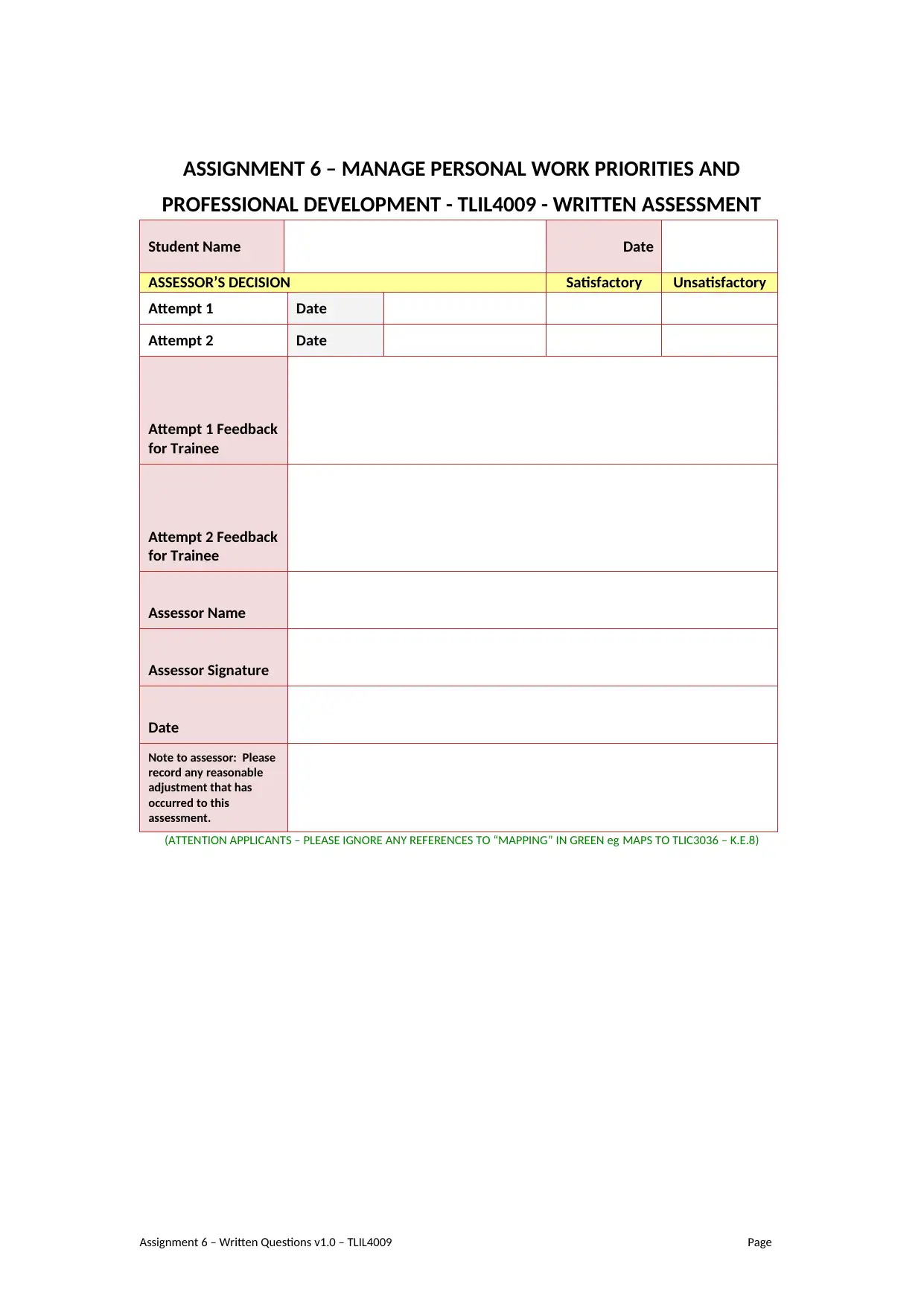
ASSIGNMENT 6 – MANAGE PERSONAL WORK PRIORITIES AND
PROFESSIONAL DEVELOPMENT - TLIL4009 - WRITTEN ASSESSMENT
Student Name Date
ASSESSOR’S DECISION Satisfactory Unsatisfactory
Attempt 1 Date
Attempt 2 Date
Attempt 1 Feedback
for Trainee
Attempt 2 Feedback
for Trainee
Assessor Name
Assessor Signature
Date
Note to assessor: Please
record any reasonable
adjustment that has
occurred to this
assessment.
(ATTENTION APPLICANTS – PLEASE IGNORE ANY REFERENCES TO “MAPPING” IN GREEN eg MAPS TO TLIC3036 – K.E.8)
Assignment 6 – Written Questions v1.0 – TLIL4009 Page
PROFESSIONAL DEVELOPMENT - TLIL4009 - WRITTEN ASSESSMENT
Student Name Date
ASSESSOR’S DECISION Satisfactory Unsatisfactory
Attempt 1 Date
Attempt 2 Date
Attempt 1 Feedback
for Trainee
Attempt 2 Feedback
for Trainee
Assessor Name
Assessor Signature
Date
Note to assessor: Please
record any reasonable
adjustment that has
occurred to this
assessment.
(ATTENTION APPLICANTS – PLEASE IGNORE ANY REFERENCES TO “MAPPING” IN GREEN eg MAPS TO TLIC3036 – K.E.8)
Assignment 6 – Written Questions v1.0 – TLIL4009 Page
Paraphrase This Document
Need a fresh take? Get an instant paraphrase of this document with our AI Paraphraser
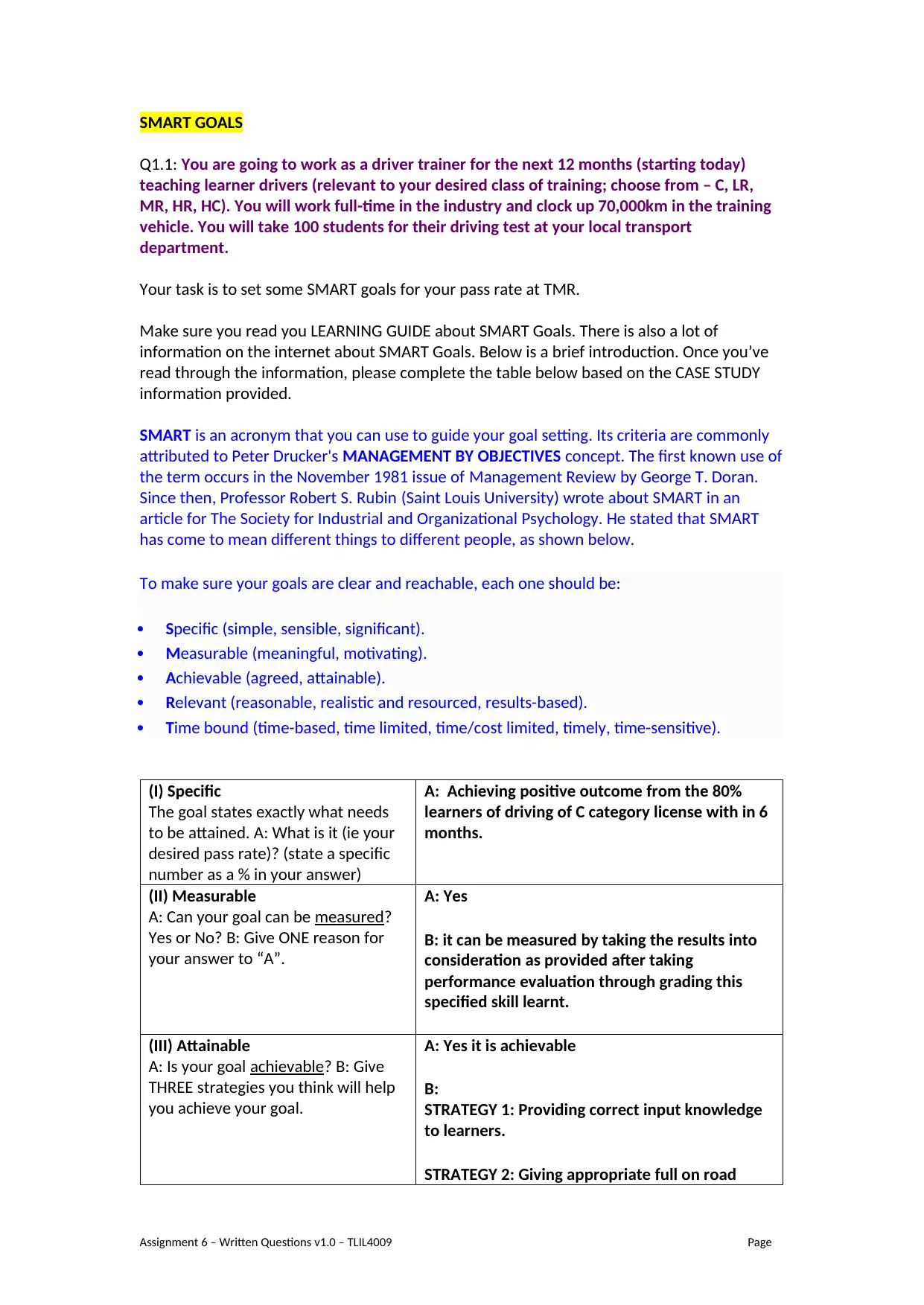
SMART GOALS
Q1.1: You are going to work as a driver trainer for the next 12 months (starting today)
teaching learner drivers (relevant to your desired class of training; choose from – C, LR,
MR, HR, HC). You will work full-time in the industry and clock up 70,000km in the training
vehicle. You will take 100 students for their driving test at your local transport
department.
Your task is to set some SMART goals for your pass rate at TMR.
Make sure you read you LEARNING GUIDE about SMART Goals. There is also a lot of
information on the internet about SMART Goals. Below is a brief introduction. Once you’ve
read through the information, please complete the table below based on the CASE STUDY
information provided.
SMART is an acronym that you can use to guide your goal setting. Its criteria are commonly
attributed to Peter Drucker's MANAGEMENT BY OBJECTIVES concept. The first known use of
the term occurs in the November 1981 issue of Management Review by George T. Doran.
Since then, Professor Robert S. Rubin (Saint Louis University) wrote about SMART in an
article for The Society for Industrial and Organizational Psychology. He stated that SMART
has come to mean different things to different people, as shown below.
To make sure your goals are clear and reachable, each one should be:
Specific (simple, sensible, significant).
Measurable (meaningful, motivating).
Achievable (agreed, attainable).
Relevant (reasonable, realistic and resourced, results-based).
Time bound (time-based, time limited, time/cost limited, timely, time-sensitive).
(I) Specific
The goal states exactly what needs
to be attained. A: What is it (ie your
desired pass rate)? (state a specific
number as a % in your answer)
A: Achieving positive outcome from the 80%
learners of driving of C category license with in 6
months.
(II) Measurable
A: Can your goal can be measured?
Yes or No? B: Give ONE reason for
your answer to “A”.
A: Yes
B: it can be measured by taking the results into
consideration as provided after taking
performance evaluation through grading this
specified skill learnt.
(III) Attainable
A: Is your goal achievable? B: Give
THREE strategies you think will help
you achieve your goal.
A: Yes it is achievable
B:
STRATEGY 1: Providing correct input knowledge
to learners.
STRATEGY 2: Giving appropriate full on road
Assignment 6 – Written Questions v1.0 – TLIL4009 Page
Q1.1: You are going to work as a driver trainer for the next 12 months (starting today)
teaching learner drivers (relevant to your desired class of training; choose from – C, LR,
MR, HR, HC). You will work full-time in the industry and clock up 70,000km in the training
vehicle. You will take 100 students for their driving test at your local transport
department.
Your task is to set some SMART goals for your pass rate at TMR.
Make sure you read you LEARNING GUIDE about SMART Goals. There is also a lot of
information on the internet about SMART Goals. Below is a brief introduction. Once you’ve
read through the information, please complete the table below based on the CASE STUDY
information provided.
SMART is an acronym that you can use to guide your goal setting. Its criteria are commonly
attributed to Peter Drucker's MANAGEMENT BY OBJECTIVES concept. The first known use of
the term occurs in the November 1981 issue of Management Review by George T. Doran.
Since then, Professor Robert S. Rubin (Saint Louis University) wrote about SMART in an
article for The Society for Industrial and Organizational Psychology. He stated that SMART
has come to mean different things to different people, as shown below.
To make sure your goals are clear and reachable, each one should be:
Specific (simple, sensible, significant).
Measurable (meaningful, motivating).
Achievable (agreed, attainable).
Relevant (reasonable, realistic and resourced, results-based).
Time bound (time-based, time limited, time/cost limited, timely, time-sensitive).
(I) Specific
The goal states exactly what needs
to be attained. A: What is it (ie your
desired pass rate)? (state a specific
number as a % in your answer)
A: Achieving positive outcome from the 80%
learners of driving of C category license with in 6
months.
(II) Measurable
A: Can your goal can be measured?
Yes or No? B: Give ONE reason for
your answer to “A”.
A: Yes
B: it can be measured by taking the results into
consideration as provided after taking
performance evaluation through grading this
specified skill learnt.
(III) Attainable
A: Is your goal achievable? B: Give
THREE strategies you think will help
you achieve your goal.
A: Yes it is achievable
B:
STRATEGY 1: Providing correct input knowledge
to learners.
STRATEGY 2: Giving appropriate full on road
Assignment 6 – Written Questions v1.0 – TLIL4009 Page
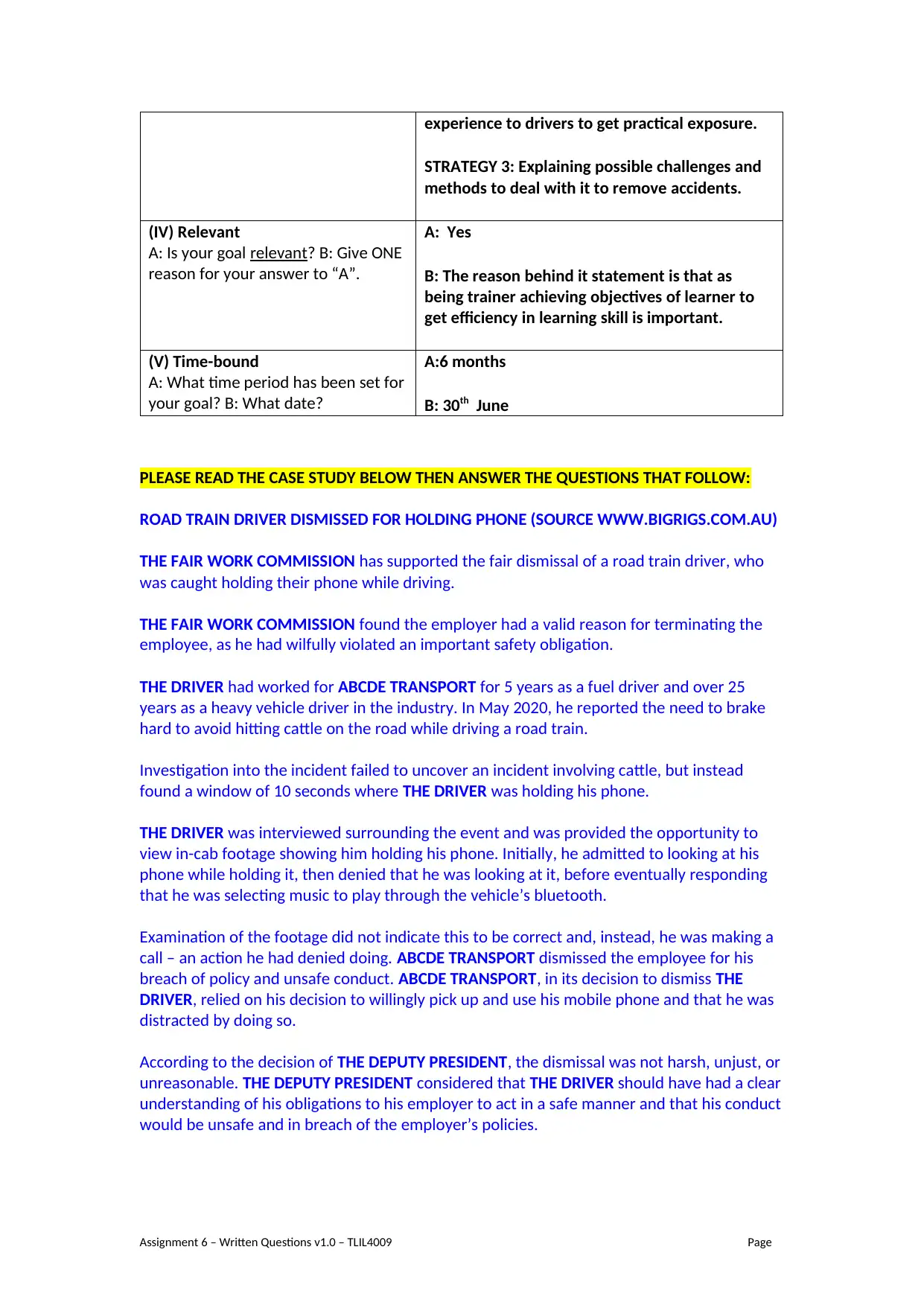
experience to drivers to get practical exposure.
STRATEGY 3: Explaining possible challenges and
methods to deal with it to remove accidents.
(IV) Relevant
A: Is your goal relevant? B: Give ONE
reason for your answer to “A”.
A: Yes
B: The reason behind it statement is that as
being trainer achieving objectives of learner to
get efficiency in learning skill is important.
(V) Time-bound
A: What time period has been set for
your goal? B: What date?
A:6 months
B: 30th June
PLEASE READ THE CASE STUDY BELOW THEN ANSWER THE QUESTIONS THAT FOLLOW:
ROAD TRAIN DRIVER DISMISSED FOR HOLDING PHONE (SOURCE WWW.BIGRIGS.COM.AU)
THE FAIR WORK COMMISSION has supported the fair dismissal of a road train driver, who
was caught holding their phone while driving.
THE FAIR WORK COMMISSION found the employer had a valid reason for terminating the
employee, as he had wilfully violated an important safety obligation.
THE DRIVER had worked for ABCDE TRANSPORT for 5 years as a fuel driver and over 25
years as a heavy vehicle driver in the industry. In May 2020, he reported the need to brake
hard to avoid hitting cattle on the road while driving a road train.
Investigation into the incident failed to uncover an incident involving cattle, but instead
found a window of 10 seconds where THE DRIVER was holding his phone.
THE DRIVER was interviewed surrounding the event and was provided the opportunity to
view in-cab footage showing him holding his phone. Initially, he admitted to looking at his
phone while holding it, then denied that he was looking at it, before eventually responding
that he was selecting music to play through the vehicle’s bluetooth.
Examination of the footage did not indicate this to be correct and, instead, he was making a
call – an action he had denied doing. ABCDE TRANSPORT dismissed the employee for his
breach of policy and unsafe conduct. ABCDE TRANSPORT, in its decision to dismiss THE
DRIVER, relied on his decision to willingly pick up and use his mobile phone and that he was
distracted by doing so.
According to the decision of THE DEPUTY PRESIDENT, the dismissal was not harsh, unjust, or
unreasonable. THE DEPUTY PRESIDENT considered that THE DRIVER should have had a clear
understanding of his obligations to his employer to act in a safe manner and that his conduct
would be unsafe and in breach of the employer’s policies.
Assignment 6 – Written Questions v1.0 – TLIL4009 Page
STRATEGY 3: Explaining possible challenges and
methods to deal with it to remove accidents.
(IV) Relevant
A: Is your goal relevant? B: Give ONE
reason for your answer to “A”.
A: Yes
B: The reason behind it statement is that as
being trainer achieving objectives of learner to
get efficiency in learning skill is important.
(V) Time-bound
A: What time period has been set for
your goal? B: What date?
A:6 months
B: 30th June
PLEASE READ THE CASE STUDY BELOW THEN ANSWER THE QUESTIONS THAT FOLLOW:
ROAD TRAIN DRIVER DISMISSED FOR HOLDING PHONE (SOURCE WWW.BIGRIGS.COM.AU)
THE FAIR WORK COMMISSION has supported the fair dismissal of a road train driver, who
was caught holding their phone while driving.
THE FAIR WORK COMMISSION found the employer had a valid reason for terminating the
employee, as he had wilfully violated an important safety obligation.
THE DRIVER had worked for ABCDE TRANSPORT for 5 years as a fuel driver and over 25
years as a heavy vehicle driver in the industry. In May 2020, he reported the need to brake
hard to avoid hitting cattle on the road while driving a road train.
Investigation into the incident failed to uncover an incident involving cattle, but instead
found a window of 10 seconds where THE DRIVER was holding his phone.
THE DRIVER was interviewed surrounding the event and was provided the opportunity to
view in-cab footage showing him holding his phone. Initially, he admitted to looking at his
phone while holding it, then denied that he was looking at it, before eventually responding
that he was selecting music to play through the vehicle’s bluetooth.
Examination of the footage did not indicate this to be correct and, instead, he was making a
call – an action he had denied doing. ABCDE TRANSPORT dismissed the employee for his
breach of policy and unsafe conduct. ABCDE TRANSPORT, in its decision to dismiss THE
DRIVER, relied on his decision to willingly pick up and use his mobile phone and that he was
distracted by doing so.
According to the decision of THE DEPUTY PRESIDENT, the dismissal was not harsh, unjust, or
unreasonable. THE DEPUTY PRESIDENT considered that THE DRIVER should have had a clear
understanding of his obligations to his employer to act in a safe manner and that his conduct
would be unsafe and in breach of the employer’s policies.
Assignment 6 – Written Questions v1.0 – TLIL4009 Page
⊘ This is a preview!⊘
Do you want full access?
Subscribe today to unlock all pages.

Trusted by 1+ million students worldwide
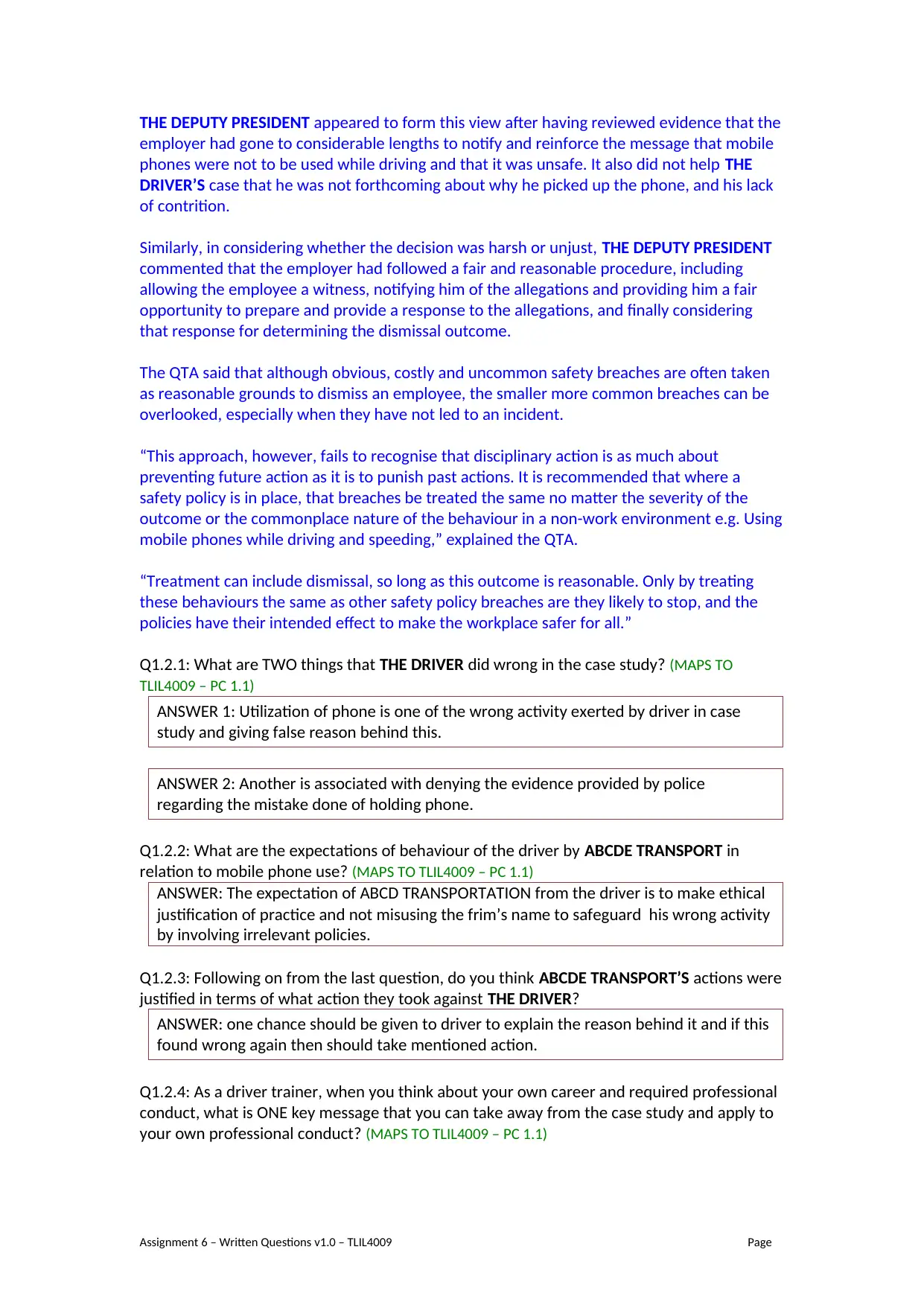
THE DEPUTY PRESIDENT appeared to form this view after having reviewed evidence that the
employer had gone to considerable lengths to notify and reinforce the message that mobile
phones were not to be used while driving and that it was unsafe. It also did not help THE
DRIVER’S case that he was not forthcoming about why he picked up the phone, and his lack
of contrition.
Similarly, in considering whether the decision was harsh or unjust, THE DEPUTY PRESIDENT
commented that the employer had followed a fair and reasonable procedure, including
allowing the employee a witness, notifying him of the allegations and providing him a fair
opportunity to prepare and provide a response to the allegations, and finally considering
that response for determining the dismissal outcome.
The QTA said that although obvious, costly and uncommon safety breaches are often taken
as reasonable grounds to dismiss an employee, the smaller more common breaches can be
overlooked, especially when they have not led to an incident.
“This approach, however, fails to recognise that disciplinary action is as much about
preventing future action as it is to punish past actions. It is recommended that where a
safety policy is in place, that breaches be treated the same no matter the severity of the
outcome or the commonplace nature of the behaviour in a non-work environment e.g. Using
mobile phones while driving and speeding,” explained the QTA.
“Treatment can include dismissal, so long as this outcome is reasonable. Only by treating
these behaviours the same as other safety policy breaches are they likely to stop, and the
policies have their intended effect to make the workplace safer for all.”
Q1.2.1: What are TWO things that THE DRIVER did wrong in the case study? (MAPS TO
TLIL4009 – PC 1.1)
ANSWER 1: Utilization of phone is one of the wrong activity exerted by driver in case
study and giving false reason behind this.
ANSWER 2: Another is associated with denying the evidence provided by police
regarding the mistake done of holding phone.
Q1.2.2: What are the expectations of behaviour of the driver by ABCDE TRANSPORT in
relation to mobile phone use? (MAPS TO TLIL4009 – PC 1.1)
ANSWER: The expectation of ABCD TRANSPORTATION from the driver is to make ethical
justification of practice and not misusing the frim’s name to safeguard his wrong activity
by involving irrelevant policies.
Q1.2.3: Following on from the last question, do you think ABCDE TRANSPORT’S actions were
justified in terms of what action they took against THE DRIVER?
ANSWER: one chance should be given to driver to explain the reason behind it and if this
found wrong again then should take mentioned action.
Q1.2.4: As a driver trainer, when you think about your own career and required professional
conduct, what is ONE key message that you can take away from the case study and apply to
your own professional conduct? (MAPS TO TLIL4009 – PC 1.1)
Assignment 6 – Written Questions v1.0 – TLIL4009 Page
employer had gone to considerable lengths to notify and reinforce the message that mobile
phones were not to be used while driving and that it was unsafe. It also did not help THE
DRIVER’S case that he was not forthcoming about why he picked up the phone, and his lack
of contrition.
Similarly, in considering whether the decision was harsh or unjust, THE DEPUTY PRESIDENT
commented that the employer had followed a fair and reasonable procedure, including
allowing the employee a witness, notifying him of the allegations and providing him a fair
opportunity to prepare and provide a response to the allegations, and finally considering
that response for determining the dismissal outcome.
The QTA said that although obvious, costly and uncommon safety breaches are often taken
as reasonable grounds to dismiss an employee, the smaller more common breaches can be
overlooked, especially when they have not led to an incident.
“This approach, however, fails to recognise that disciplinary action is as much about
preventing future action as it is to punish past actions. It is recommended that where a
safety policy is in place, that breaches be treated the same no matter the severity of the
outcome or the commonplace nature of the behaviour in a non-work environment e.g. Using
mobile phones while driving and speeding,” explained the QTA.
“Treatment can include dismissal, so long as this outcome is reasonable. Only by treating
these behaviours the same as other safety policy breaches are they likely to stop, and the
policies have their intended effect to make the workplace safer for all.”
Q1.2.1: What are TWO things that THE DRIVER did wrong in the case study? (MAPS TO
TLIL4009 – PC 1.1)
ANSWER 1: Utilization of phone is one of the wrong activity exerted by driver in case
study and giving false reason behind this.
ANSWER 2: Another is associated with denying the evidence provided by police
regarding the mistake done of holding phone.
Q1.2.2: What are the expectations of behaviour of the driver by ABCDE TRANSPORT in
relation to mobile phone use? (MAPS TO TLIL4009 – PC 1.1)
ANSWER: The expectation of ABCD TRANSPORTATION from the driver is to make ethical
justification of practice and not misusing the frim’s name to safeguard his wrong activity
by involving irrelevant policies.
Q1.2.3: Following on from the last question, do you think ABCDE TRANSPORT’S actions were
justified in terms of what action they took against THE DRIVER?
ANSWER: one chance should be given to driver to explain the reason behind it and if this
found wrong again then should take mentioned action.
Q1.2.4: As a driver trainer, when you think about your own career and required professional
conduct, what is ONE key message that you can take away from the case study and apply to
your own professional conduct? (MAPS TO TLIL4009 – PC 1.1)
Assignment 6 – Written Questions v1.0 – TLIL4009 Page
Paraphrase This Document
Need a fresh take? Get an instant paraphrase of this document with our AI Paraphraser
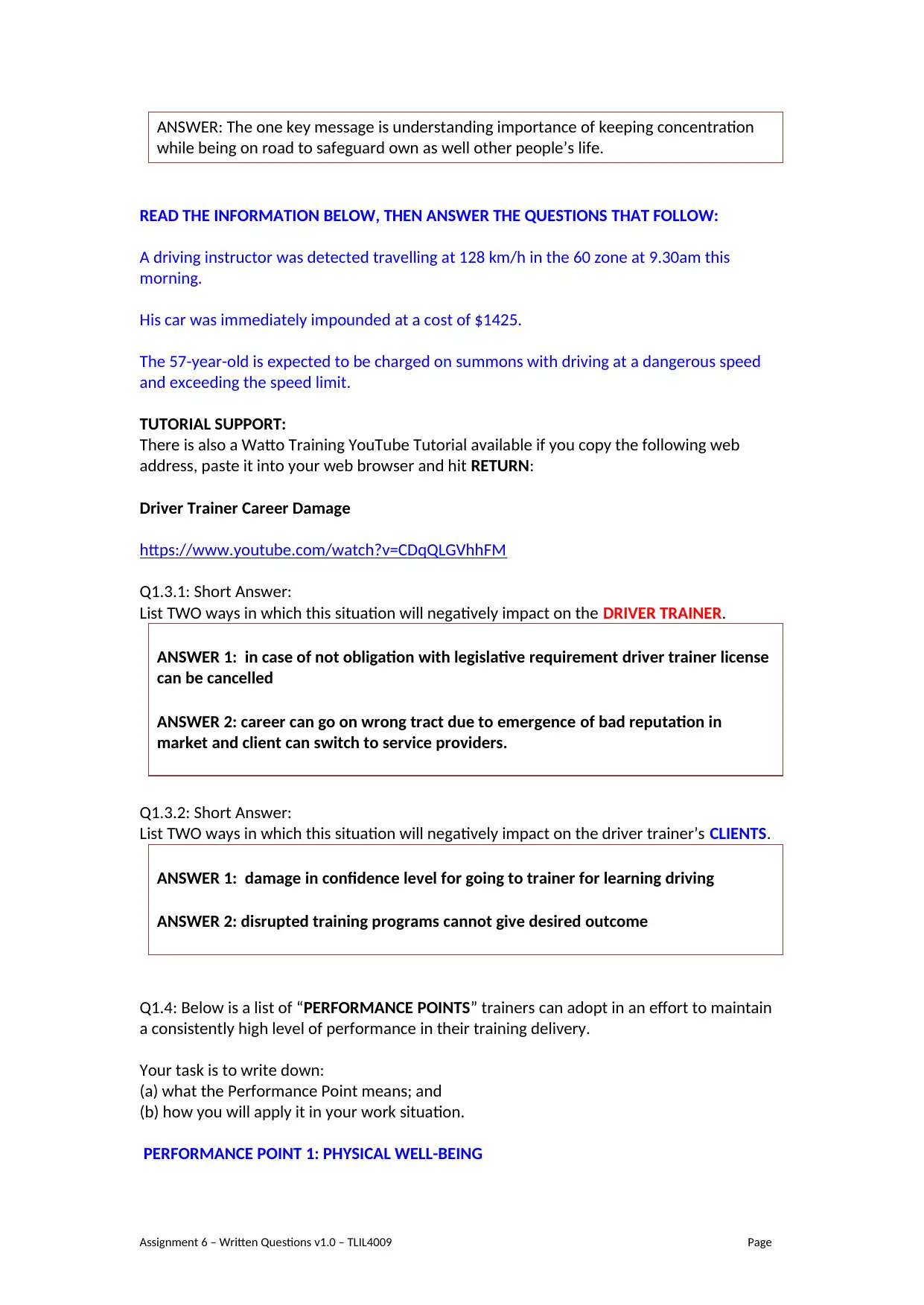
ANSWER: The one key message is understanding importance of keeping concentration
while being on road to safeguard own as well other people’s life.
READ THE INFORMATION BELOW, THEN ANSWER THE QUESTIONS THAT FOLLOW:
A driving instructor was detected travelling at 128 km/h in the 60 zone at 9.30am this
morning.
His car was immediately impounded at a cost of $1425.
The 57-year-old is expected to be charged on summons with driving at a dangerous speed
and exceeding the speed limit.
TUTORIAL SUPPORT:
There is also a Watto Training YouTube Tutorial available if you copy the following web
address, paste it into your web browser and hit RETURN:
Driver Trainer Career Damage
https://www.youtube.com/watch?v=CDqQLGVhhFM
Q1.3.1: Short Answer:
List TWO ways in which this situation will negatively impact on the DRIVER TRAINER.
ANSWER 1: in case of not obligation with legislative requirement driver trainer license
can be cancelled
ANSWER 2: career can go on wrong tract due to emergence of bad reputation in
market and client can switch to service providers.
Q1.3.2: Short Answer:
List TWO ways in which this situation will negatively impact on the driver trainer’s CLIENTS.
ANSWER 1: damage in confidence level for going to trainer for learning driving
ANSWER 2: disrupted training programs cannot give desired outcome
Q1.4: Below is a list of “PERFORMANCE POINTS” trainers can adopt in an effort to maintain
a consistently high level of performance in their training delivery.
Your task is to write down:
(a) what the Performance Point means; and
(b) how you will apply it in your work situation.
PERFORMANCE POINT 1: PHYSICAL WELL-BEING
Assignment 6 – Written Questions v1.0 – TLIL4009 Page
while being on road to safeguard own as well other people’s life.
READ THE INFORMATION BELOW, THEN ANSWER THE QUESTIONS THAT FOLLOW:
A driving instructor was detected travelling at 128 km/h in the 60 zone at 9.30am this
morning.
His car was immediately impounded at a cost of $1425.
The 57-year-old is expected to be charged on summons with driving at a dangerous speed
and exceeding the speed limit.
TUTORIAL SUPPORT:
There is also a Watto Training YouTube Tutorial available if you copy the following web
address, paste it into your web browser and hit RETURN:
Driver Trainer Career Damage
https://www.youtube.com/watch?v=CDqQLGVhhFM
Q1.3.1: Short Answer:
List TWO ways in which this situation will negatively impact on the DRIVER TRAINER.
ANSWER 1: in case of not obligation with legislative requirement driver trainer license
can be cancelled
ANSWER 2: career can go on wrong tract due to emergence of bad reputation in
market and client can switch to service providers.
Q1.3.2: Short Answer:
List TWO ways in which this situation will negatively impact on the driver trainer’s CLIENTS.
ANSWER 1: damage in confidence level for going to trainer for learning driving
ANSWER 2: disrupted training programs cannot give desired outcome
Q1.4: Below is a list of “PERFORMANCE POINTS” trainers can adopt in an effort to maintain
a consistently high level of performance in their training delivery.
Your task is to write down:
(a) what the Performance Point means; and
(b) how you will apply it in your work situation.
PERFORMANCE POINT 1: PHYSICAL WELL-BEING
Assignment 6 – Written Questions v1.0 – TLIL4009 Page
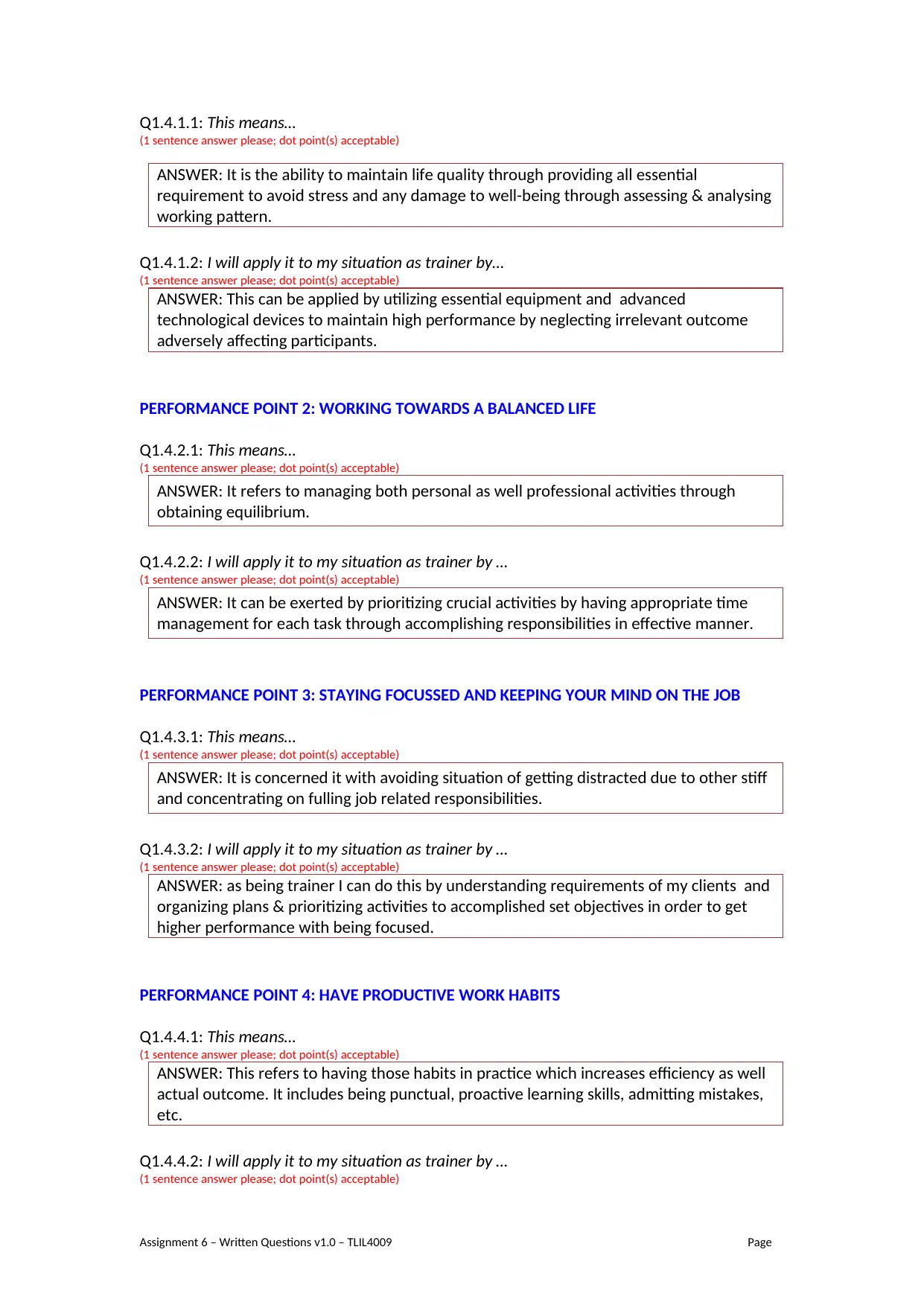
Q1.4.1.1: This means…
(1 sentence answer please; dot point(s) acceptable)
ANSWER: It is the ability to maintain life quality through providing all essential
requirement to avoid stress and any damage to well-being through assessing & analysing
working pattern.
Q1.4.1.2: I will apply it to my situation as trainer by…
(1 sentence answer please; dot point(s) acceptable)
ANSWER: This can be applied by utilizing essential equipment and advanced
technological devices to maintain high performance by neglecting irrelevant outcome
adversely affecting participants.
PERFORMANCE POINT 2: WORKING TOWARDS A BALANCED LIFE
Q1.4.2.1: This means…
(1 sentence answer please; dot point(s) acceptable)
ANSWER: It refers to managing both personal as well professional activities through
obtaining equilibrium.
Q1.4.2.2: I will apply it to my situation as trainer by …
(1 sentence answer please; dot point(s) acceptable)
ANSWER: It can be exerted by prioritizing crucial activities by having appropriate time
management for each task through accomplishing responsibilities in effective manner.
PERFORMANCE POINT 3: STAYING FOCUSSED AND KEEPING YOUR MIND ON THE JOB
Q1.4.3.1: This means…
(1 sentence answer please; dot point(s) acceptable)
ANSWER: It is concerned it with avoiding situation of getting distracted due to other stiff
and concentrating on fulling job related responsibilities.
Q1.4.3.2: I will apply it to my situation as trainer by …
(1 sentence answer please; dot point(s) acceptable)
ANSWER: as being trainer I can do this by understanding requirements of my clients and
organizing plans & prioritizing activities to accomplished set objectives in order to get
higher performance with being focused.
PERFORMANCE POINT 4: HAVE PRODUCTIVE WORK HABITS
Q1.4.4.1: This means…
(1 sentence answer please; dot point(s) acceptable)
ANSWER: This refers to having those habits in practice which increases efficiency as well
actual outcome. It includes being punctual, proactive learning skills, admitting mistakes,
etc.
Q1.4.4.2: I will apply it to my situation as trainer by …
(1 sentence answer please; dot point(s) acceptable)
Assignment 6 – Written Questions v1.0 – TLIL4009 Page
(1 sentence answer please; dot point(s) acceptable)
ANSWER: It is the ability to maintain life quality through providing all essential
requirement to avoid stress and any damage to well-being through assessing & analysing
working pattern.
Q1.4.1.2: I will apply it to my situation as trainer by…
(1 sentence answer please; dot point(s) acceptable)
ANSWER: This can be applied by utilizing essential equipment and advanced
technological devices to maintain high performance by neglecting irrelevant outcome
adversely affecting participants.
PERFORMANCE POINT 2: WORKING TOWARDS A BALANCED LIFE
Q1.4.2.1: This means…
(1 sentence answer please; dot point(s) acceptable)
ANSWER: It refers to managing both personal as well professional activities through
obtaining equilibrium.
Q1.4.2.2: I will apply it to my situation as trainer by …
(1 sentence answer please; dot point(s) acceptable)
ANSWER: It can be exerted by prioritizing crucial activities by having appropriate time
management for each task through accomplishing responsibilities in effective manner.
PERFORMANCE POINT 3: STAYING FOCUSSED AND KEEPING YOUR MIND ON THE JOB
Q1.4.3.1: This means…
(1 sentence answer please; dot point(s) acceptable)
ANSWER: It is concerned it with avoiding situation of getting distracted due to other stiff
and concentrating on fulling job related responsibilities.
Q1.4.3.2: I will apply it to my situation as trainer by …
(1 sentence answer please; dot point(s) acceptable)
ANSWER: as being trainer I can do this by understanding requirements of my clients and
organizing plans & prioritizing activities to accomplished set objectives in order to get
higher performance with being focused.
PERFORMANCE POINT 4: HAVE PRODUCTIVE WORK HABITS
Q1.4.4.1: This means…
(1 sentence answer please; dot point(s) acceptable)
ANSWER: This refers to having those habits in practice which increases efficiency as well
actual outcome. It includes being punctual, proactive learning skills, admitting mistakes,
etc.
Q1.4.4.2: I will apply it to my situation as trainer by …
(1 sentence answer please; dot point(s) acceptable)
Assignment 6 – Written Questions v1.0 – TLIL4009 Page
⊘ This is a preview!⊘
Do you want full access?
Subscribe today to unlock all pages.

Trusted by 1+ million students worldwide
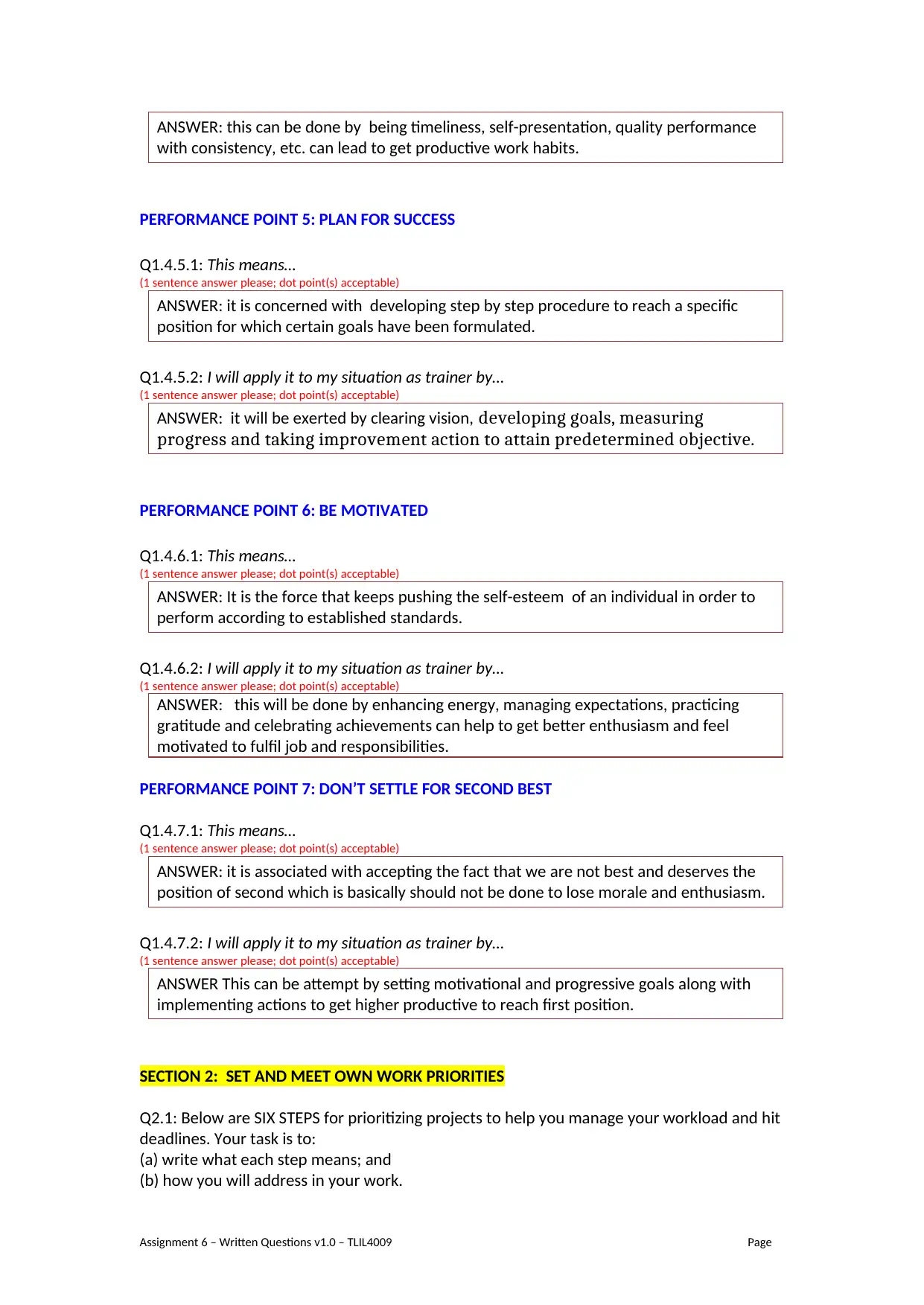
ANSWER: this can be done by being timeliness, self-presentation, quality performance
with consistency, etc. can lead to get productive work habits.
PERFORMANCE POINT 5: PLAN FOR SUCCESS
Q1.4.5.1: This means…
(1 sentence answer please; dot point(s) acceptable)
ANSWER: it is concerned with developing step by step procedure to reach a specific
position for which certain goals have been formulated.
Q1.4.5.2: I will apply it to my situation as trainer by…
(1 sentence answer please; dot point(s) acceptable)
ANSWER: it will be exerted by clearing vision, developing goals, measuring
progress and taking improvement action to attain predetermined objective.
PERFORMANCE POINT 6: BE MOTIVATED
Q1.4.6.1: This means…
(1 sentence answer please; dot point(s) acceptable)
ANSWER: It is the force that keeps pushing the self-esteem of an individual in order to
perform according to established standards.
Q1.4.6.2: I will apply it to my situation as trainer by…
(1 sentence answer please; dot point(s) acceptable)
ANSWER: this will be done by enhancing energy, managing expectations, practicing
gratitude and celebrating achievements can help to get better enthusiasm and feel
motivated to fulfil job and responsibilities.
PERFORMANCE POINT 7: DON’T SETTLE FOR SECOND BEST
Q1.4.7.1: This means…
(1 sentence answer please; dot point(s) acceptable)
ANSWER: it is associated with accepting the fact that we are not best and deserves the
position of second which is basically should not be done to lose morale and enthusiasm.
Q1.4.7.2: I will apply it to my situation as trainer by…
(1 sentence answer please; dot point(s) acceptable)
ANSWER This can be attempt by setting motivational and progressive goals along with
implementing actions to get higher productive to reach first position.
SECTION 2: SET AND MEET OWN WORK PRIORITIES
Q2.1: Below are SIX STEPS for prioritizing projects to help you manage your workload and hit
deadlines. Your task is to:
(a) write what each step means; and
(b) how you will address in your work.
Assignment 6 – Written Questions v1.0 – TLIL4009 Page
with consistency, etc. can lead to get productive work habits.
PERFORMANCE POINT 5: PLAN FOR SUCCESS
Q1.4.5.1: This means…
(1 sentence answer please; dot point(s) acceptable)
ANSWER: it is concerned with developing step by step procedure to reach a specific
position for which certain goals have been formulated.
Q1.4.5.2: I will apply it to my situation as trainer by…
(1 sentence answer please; dot point(s) acceptable)
ANSWER: it will be exerted by clearing vision, developing goals, measuring
progress and taking improvement action to attain predetermined objective.
PERFORMANCE POINT 6: BE MOTIVATED
Q1.4.6.1: This means…
(1 sentence answer please; dot point(s) acceptable)
ANSWER: It is the force that keeps pushing the self-esteem of an individual in order to
perform according to established standards.
Q1.4.6.2: I will apply it to my situation as trainer by…
(1 sentence answer please; dot point(s) acceptable)
ANSWER: this will be done by enhancing energy, managing expectations, practicing
gratitude and celebrating achievements can help to get better enthusiasm and feel
motivated to fulfil job and responsibilities.
PERFORMANCE POINT 7: DON’T SETTLE FOR SECOND BEST
Q1.4.7.1: This means…
(1 sentence answer please; dot point(s) acceptable)
ANSWER: it is associated with accepting the fact that we are not best and deserves the
position of second which is basically should not be done to lose morale and enthusiasm.
Q1.4.7.2: I will apply it to my situation as trainer by…
(1 sentence answer please; dot point(s) acceptable)
ANSWER This can be attempt by setting motivational and progressive goals along with
implementing actions to get higher productive to reach first position.
SECTION 2: SET AND MEET OWN WORK PRIORITIES
Q2.1: Below are SIX STEPS for prioritizing projects to help you manage your workload and hit
deadlines. Your task is to:
(a) write what each step means; and
(b) how you will address in your work.
Assignment 6 – Written Questions v1.0 – TLIL4009 Page
Paraphrase This Document
Need a fresh take? Get an instant paraphrase of this document with our AI Paraphraser
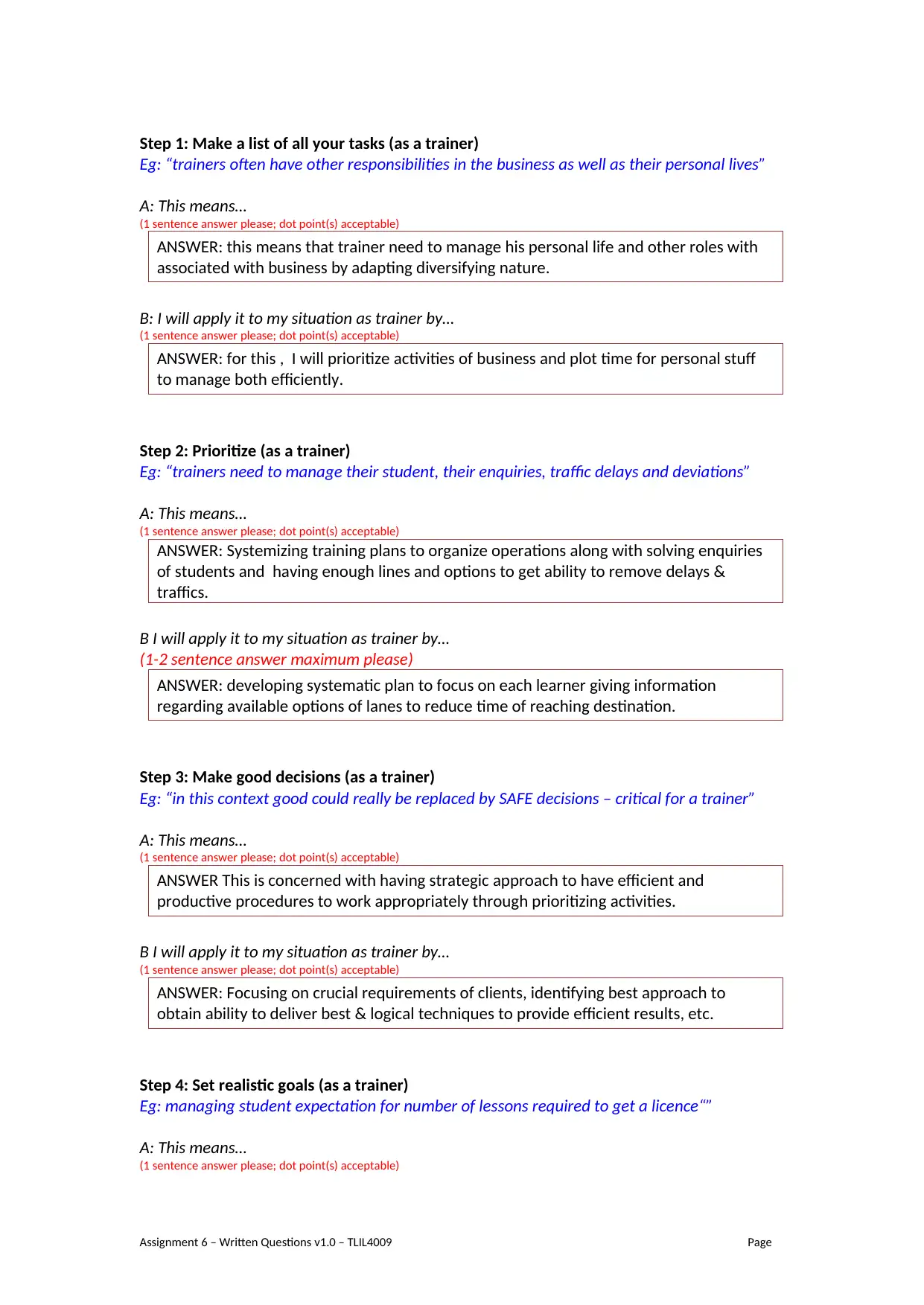
Step 1: Make a list of all your tasks (as a trainer)
Eg: “trainers often have other responsibilities in the business as well as their personal lives”
A: This means…
(1 sentence answer please; dot point(s) acceptable)
ANSWER: this means that trainer need to manage his personal life and other roles with
associated with business by adapting diversifying nature.
B: I will apply it to my situation as trainer by…
(1 sentence answer please; dot point(s) acceptable)
ANSWER: for this , I will prioritize activities of business and plot time for personal stuff
to manage both efficiently.
Step 2: Prioritize (as a trainer)
Eg: “trainers need to manage their student, their enquiries, traffic delays and deviations”
A: This means…
(1 sentence answer please; dot point(s) acceptable)
ANSWER: Systemizing training plans to organize operations along with solving enquiries
of students and having enough lines and options to get ability to remove delays &
traffics.
B I will apply it to my situation as trainer by…
(1-2 sentence answer maximum please)
ANSWER: developing systematic plan to focus on each learner giving information
regarding available options of lanes to reduce time of reaching destination.
Step 3: Make good decisions (as a trainer)
Eg: “in this context good could really be replaced by SAFE decisions – critical for a trainer”
A: This means…
(1 sentence answer please; dot point(s) acceptable)
ANSWER This is concerned with having strategic approach to have efficient and
productive procedures to work appropriately through prioritizing activities.
B I will apply it to my situation as trainer by…
(1 sentence answer please; dot point(s) acceptable)
ANSWER: Focusing on crucial requirements of clients, identifying best approach to
obtain ability to deliver best & logical techniques to provide efficient results, etc.
Step 4: Set realistic goals (as a trainer)
Eg: managing student expectation for number of lessons required to get a licence“”
A: This means…
(1 sentence answer please; dot point(s) acceptable)
Assignment 6 – Written Questions v1.0 – TLIL4009 Page
Eg: “trainers often have other responsibilities in the business as well as their personal lives”
A: This means…
(1 sentence answer please; dot point(s) acceptable)
ANSWER: this means that trainer need to manage his personal life and other roles with
associated with business by adapting diversifying nature.
B: I will apply it to my situation as trainer by…
(1 sentence answer please; dot point(s) acceptable)
ANSWER: for this , I will prioritize activities of business and plot time for personal stuff
to manage both efficiently.
Step 2: Prioritize (as a trainer)
Eg: “trainers need to manage their student, their enquiries, traffic delays and deviations”
A: This means…
(1 sentence answer please; dot point(s) acceptable)
ANSWER: Systemizing training plans to organize operations along with solving enquiries
of students and having enough lines and options to get ability to remove delays &
traffics.
B I will apply it to my situation as trainer by…
(1-2 sentence answer maximum please)
ANSWER: developing systematic plan to focus on each learner giving information
regarding available options of lanes to reduce time of reaching destination.
Step 3: Make good decisions (as a trainer)
Eg: “in this context good could really be replaced by SAFE decisions – critical for a trainer”
A: This means…
(1 sentence answer please; dot point(s) acceptable)
ANSWER This is concerned with having strategic approach to have efficient and
productive procedures to work appropriately through prioritizing activities.
B I will apply it to my situation as trainer by…
(1 sentence answer please; dot point(s) acceptable)
ANSWER: Focusing on crucial requirements of clients, identifying best approach to
obtain ability to deliver best & logical techniques to provide efficient results, etc.
Step 4: Set realistic goals (as a trainer)
Eg: managing student expectation for number of lessons required to get a licence“”
A: This means…
(1 sentence answer please; dot point(s) acceptable)
Assignment 6 – Written Questions v1.0 – TLIL4009 Page
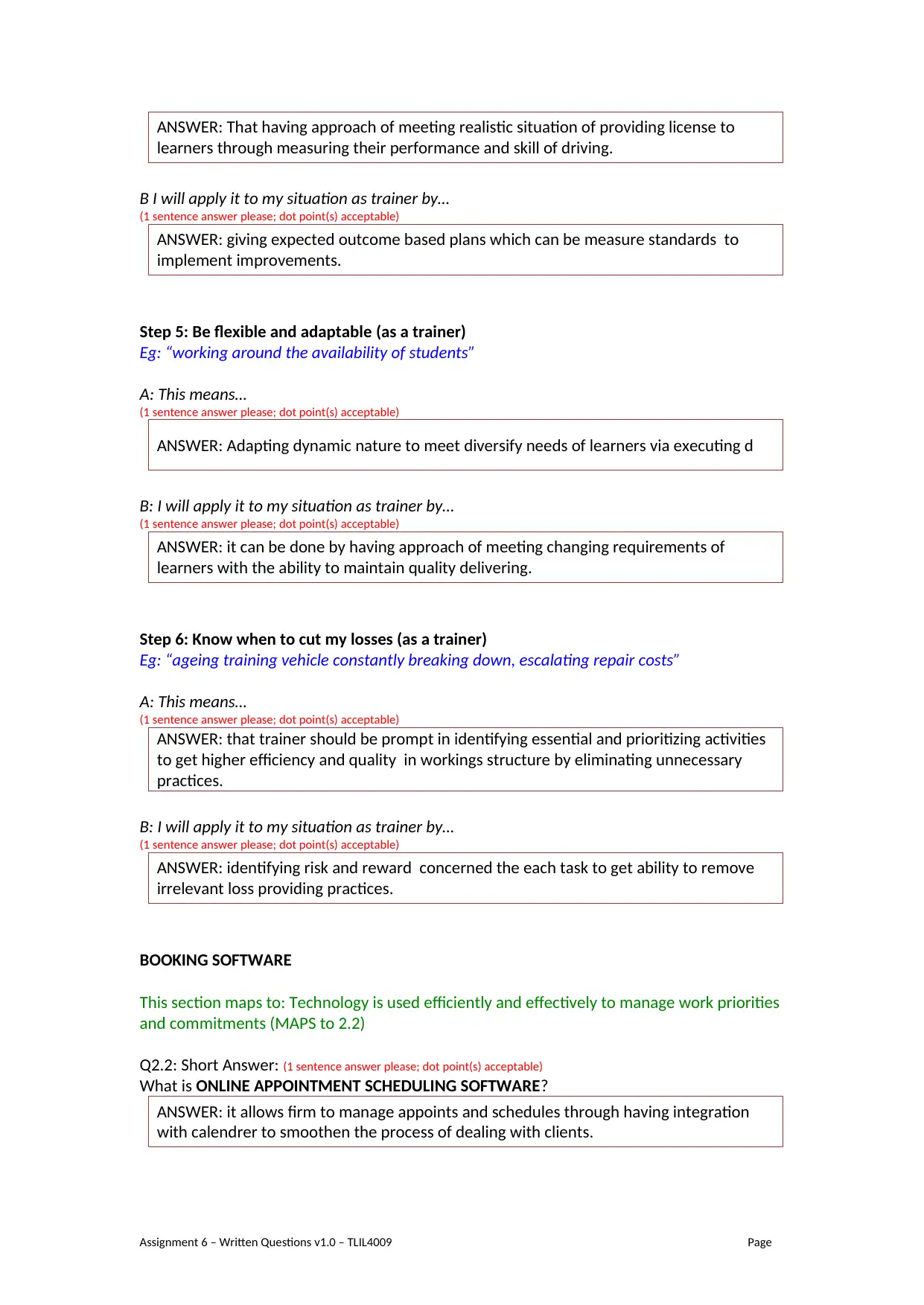
ANSWER: That having approach of meeting realistic situation of providing license to
learners through measuring their performance and skill of driving.
B I will apply it to my situation as trainer by…
(1 sentence answer please; dot point(s) acceptable)
ANSWER: giving expected outcome based plans which can be measure standards to
implement improvements.
Step 5: Be flexible and adaptable (as a trainer)
Eg: “working around the availability of students”
A: This means…
(1 sentence answer please; dot point(s) acceptable)
ANSWER: Adapting dynamic nature to meet diversify needs of learners via executing d
B: I will apply it to my situation as trainer by…
(1 sentence answer please; dot point(s) acceptable)
ANSWER: it can be done by having approach of meeting changing requirements of
learners with the ability to maintain quality delivering.
Step 6: Know when to cut my losses (as a trainer)
Eg: “ageing training vehicle constantly breaking down, escalating repair costs”
A: This means…
(1 sentence answer please; dot point(s) acceptable)
ANSWER: that trainer should be prompt in identifying essential and prioritizing activities
to get higher efficiency and quality in workings structure by eliminating unnecessary
practices.
B: I will apply it to my situation as trainer by…
(1 sentence answer please; dot point(s) acceptable)
ANSWER: identifying risk and reward concerned the each task to get ability to remove
irrelevant loss providing practices.
BOOKING SOFTWARE
This section maps to: Technology is used efficiently and effectively to manage work priorities
and commitments (MAPS to 2.2)
Q2.2: Short Answer: (1 sentence answer please; dot point(s) acceptable)
What is ONLINE APPOINTMENT SCHEDULING SOFTWARE?
ANSWER: it allows firm to manage appoints and schedules through having integration
with calendrer to smoothen the process of dealing with clients.
Assignment 6 – Written Questions v1.0 – TLIL4009 Page
learners through measuring their performance and skill of driving.
B I will apply it to my situation as trainer by…
(1 sentence answer please; dot point(s) acceptable)
ANSWER: giving expected outcome based plans which can be measure standards to
implement improvements.
Step 5: Be flexible and adaptable (as a trainer)
Eg: “working around the availability of students”
A: This means…
(1 sentence answer please; dot point(s) acceptable)
ANSWER: Adapting dynamic nature to meet diversify needs of learners via executing d
B: I will apply it to my situation as trainer by…
(1 sentence answer please; dot point(s) acceptable)
ANSWER: it can be done by having approach of meeting changing requirements of
learners with the ability to maintain quality delivering.
Step 6: Know when to cut my losses (as a trainer)
Eg: “ageing training vehicle constantly breaking down, escalating repair costs”
A: This means…
(1 sentence answer please; dot point(s) acceptable)
ANSWER: that trainer should be prompt in identifying essential and prioritizing activities
to get higher efficiency and quality in workings structure by eliminating unnecessary
practices.
B: I will apply it to my situation as trainer by…
(1 sentence answer please; dot point(s) acceptable)
ANSWER: identifying risk and reward concerned the each task to get ability to remove
irrelevant loss providing practices.
BOOKING SOFTWARE
This section maps to: Technology is used efficiently and effectively to manage work priorities
and commitments (MAPS to 2.2)
Q2.2: Short Answer: (1 sentence answer please; dot point(s) acceptable)
What is ONLINE APPOINTMENT SCHEDULING SOFTWARE?
ANSWER: it allows firm to manage appoints and schedules through having integration
with calendrer to smoothen the process of dealing with clients.
Assignment 6 – Written Questions v1.0 – TLIL4009 Page
⊘ This is a preview!⊘
Do you want full access?
Subscribe today to unlock all pages.

Trusted by 1+ million students worldwide
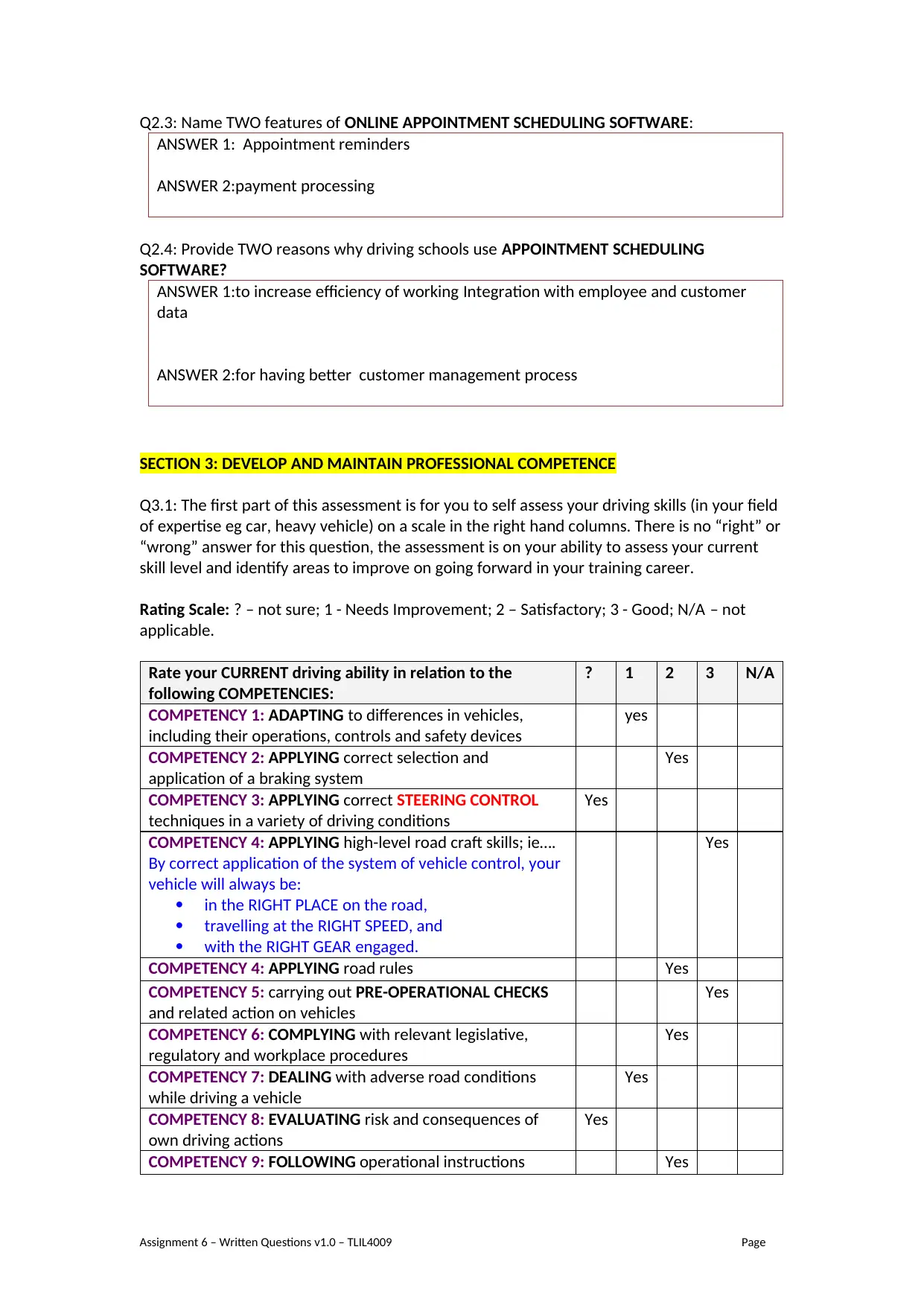
Q2.3: Name TWO features of ONLINE APPOINTMENT SCHEDULING SOFTWARE:
ANSWER 1: Appointment reminders
ANSWER 2:payment processing
Q2.4: Provide TWO reasons why driving schools use APPOINTMENT SCHEDULING
SOFTWARE?
ANSWER 1:to increase efficiency of working Integration with employee and customer
data
ANSWER 2:for having better customer management process
SECTION 3: DEVELOP AND MAINTAIN PROFESSIONAL COMPETENCE
Q3.1: The first part of this assessment is for you to self assess your driving skills (in your field
of expertise eg car, heavy vehicle) on a scale in the right hand columns. There is no “right” or
“wrong” answer for this question, the assessment is on your ability to assess your current
skill level and identify areas to improve on going forward in your training career.
Rating Scale: ? – not sure; 1 - Needs Improvement; 2 – Satisfactory; 3 - Good; N/A – not
applicable.
Rate your CURRENT driving ability in relation to the
following COMPETENCIES:
? 1 2 3 N/A
COMPETENCY 1: ADAPTING to differences in vehicles,
including their operations, controls and safety devices
yes
COMPETENCY 2: APPLYING correct selection and
application of a braking system
Yes
COMPETENCY 3: APPLYING correct STEERING CONTROL
techniques in a variety of driving conditions
Yes
COMPETENCY 4: APPLYING high-level road craft skills; ie….
By correct application of the system of vehicle control, your
vehicle will always be:
in the RIGHT PLACE on the road,
travelling at the RIGHT SPEED, and
with the RIGHT GEAR engaged.
Yes
COMPETENCY 4: APPLYING road rules Yes
COMPETENCY 5: carrying out PRE-OPERATIONAL CHECKS
and related action on vehicles
Yes
COMPETENCY 6: COMPLYING with relevant legislative,
regulatory and workplace procedures
Yes
COMPETENCY 7: DEALING with adverse road conditions
while driving a vehicle
Yes
COMPETENCY 8: EVALUATING risk and consequences of
own driving actions
Yes
COMPETENCY 9: FOLLOWING operational instructions Yes
Assignment 6 – Written Questions v1.0 – TLIL4009 Page
ANSWER 1: Appointment reminders
ANSWER 2:payment processing
Q2.4: Provide TWO reasons why driving schools use APPOINTMENT SCHEDULING
SOFTWARE?
ANSWER 1:to increase efficiency of working Integration with employee and customer
data
ANSWER 2:for having better customer management process
SECTION 3: DEVELOP AND MAINTAIN PROFESSIONAL COMPETENCE
Q3.1: The first part of this assessment is for you to self assess your driving skills (in your field
of expertise eg car, heavy vehicle) on a scale in the right hand columns. There is no “right” or
“wrong” answer for this question, the assessment is on your ability to assess your current
skill level and identify areas to improve on going forward in your training career.
Rating Scale: ? – not sure; 1 - Needs Improvement; 2 – Satisfactory; 3 - Good; N/A – not
applicable.
Rate your CURRENT driving ability in relation to the
following COMPETENCIES:
? 1 2 3 N/A
COMPETENCY 1: ADAPTING to differences in vehicles,
including their operations, controls and safety devices
yes
COMPETENCY 2: APPLYING correct selection and
application of a braking system
Yes
COMPETENCY 3: APPLYING correct STEERING CONTROL
techniques in a variety of driving conditions
Yes
COMPETENCY 4: APPLYING high-level road craft skills; ie….
By correct application of the system of vehicle control, your
vehicle will always be:
in the RIGHT PLACE on the road,
travelling at the RIGHT SPEED, and
with the RIGHT GEAR engaged.
Yes
COMPETENCY 4: APPLYING road rules Yes
COMPETENCY 5: carrying out PRE-OPERATIONAL CHECKS
and related action on vehicles
Yes
COMPETENCY 6: COMPLYING with relevant legislative,
regulatory and workplace procedures
Yes
COMPETENCY 7: DEALING with adverse road conditions
while driving a vehicle
Yes
COMPETENCY 8: EVALUATING risk and consequences of
own driving actions
Yes
COMPETENCY 9: FOLLOWING operational instructions Yes
Assignment 6 – Written Questions v1.0 – TLIL4009 Page
Paraphrase This Document
Need a fresh take? Get an instant paraphrase of this document with our AI Paraphraser
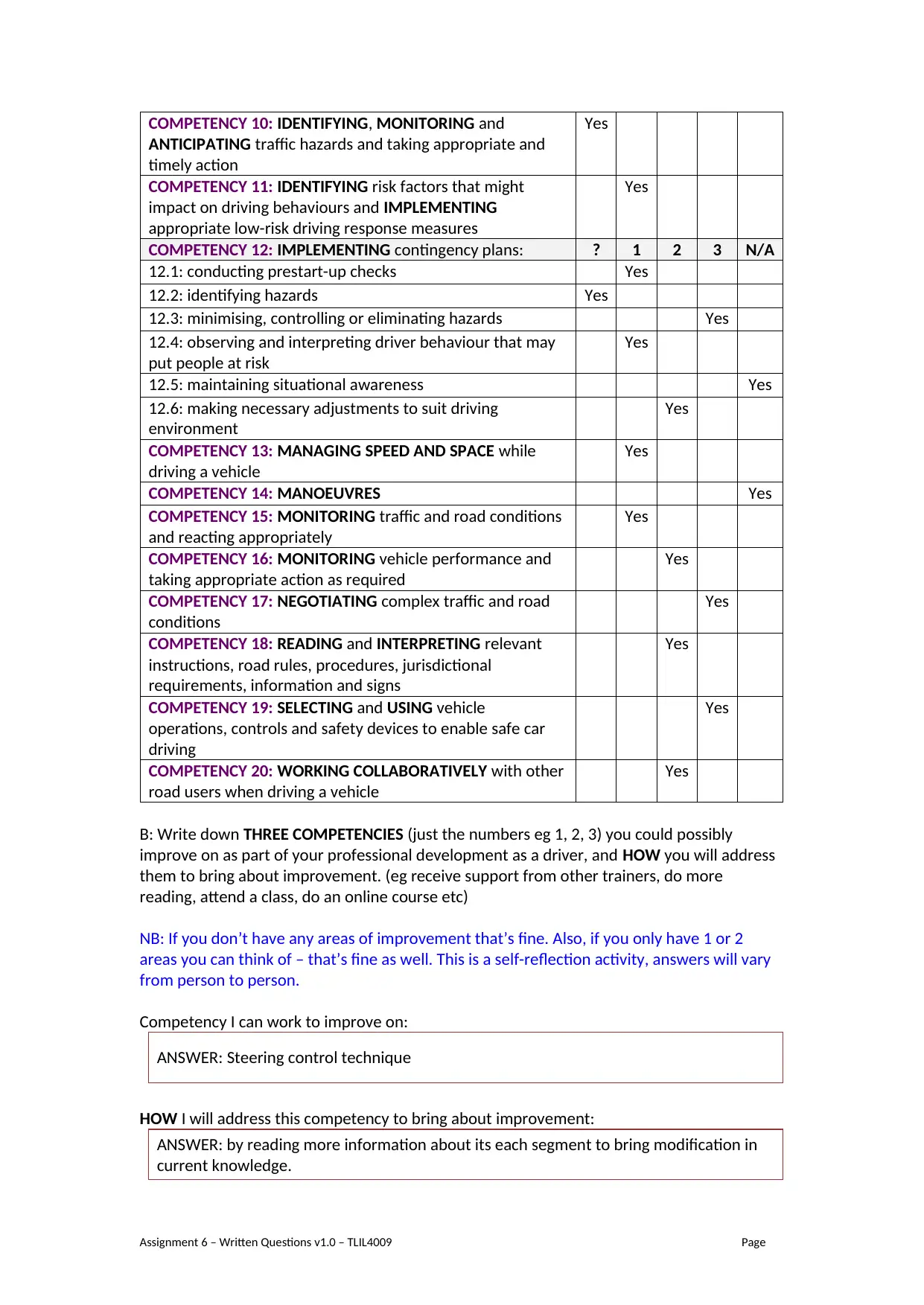
COMPETENCY 10: IDENTIFYING, MONITORING and
ANTICIPATING traffic hazards and taking appropriate and
timely action
Yes
COMPETENCY 11: IDENTIFYING risk factors that might
impact on driving behaviours and IMPLEMENTING
appropriate low-risk driving response measures
Yes
COMPETENCY 12: IMPLEMENTING contingency plans: ? 1 2 3 N/A
12.1: conducting prestart-up checks Yes
12.2: identifying hazards Yes
12.3: minimising, controlling or eliminating hazards Yes
12.4: observing and interpreting driver behaviour that may
put people at risk
Yes
12.5: maintaining situational awareness Yes
12.6: making necessary adjustments to suit driving
environment
Yes
COMPETENCY 13: MANAGING SPEED AND SPACE while
driving a vehicle
Yes
COMPETENCY 14: MANOEUVRES Yes
COMPETENCY 15: MONITORING traffic and road conditions
and reacting appropriately
Yes
COMPETENCY 16: MONITORING vehicle performance and
taking appropriate action as required
Yes
COMPETENCY 17: NEGOTIATING complex traffic and road
conditions
Yes
COMPETENCY 18: READING and INTERPRETING relevant
instructions, road rules, procedures, jurisdictional
requirements, information and signs
Yes
COMPETENCY 19: SELECTING and USING vehicle
operations, controls and safety devices to enable safe car
driving
Yes
COMPETENCY 20: WORKING COLLABORATIVELY with other
road users when driving a vehicle
Yes
B: Write down THREE COMPETENCIES (just the numbers eg 1, 2, 3) you could possibly
improve on as part of your professional development as a driver, and HOW you will address
them to bring about improvement. (eg receive support from other trainers, do more
reading, attend a class, do an online course etc)
NB: If you don’t have any areas of improvement that’s fine. Also, if you only have 1 or 2
areas you can think of – that’s fine as well. This is a self-reflection activity, answers will vary
from person to person.
Competency I can work to improve on:
ANSWER: Steering control technique
HOW I will address this competency to bring about improvement:
ANSWER: by reading more information about its each segment to bring modification in
current knowledge.
Assignment 6 – Written Questions v1.0 – TLIL4009 Page
ANTICIPATING traffic hazards and taking appropriate and
timely action
Yes
COMPETENCY 11: IDENTIFYING risk factors that might
impact on driving behaviours and IMPLEMENTING
appropriate low-risk driving response measures
Yes
COMPETENCY 12: IMPLEMENTING contingency plans: ? 1 2 3 N/A
12.1: conducting prestart-up checks Yes
12.2: identifying hazards Yes
12.3: minimising, controlling or eliminating hazards Yes
12.4: observing and interpreting driver behaviour that may
put people at risk
Yes
12.5: maintaining situational awareness Yes
12.6: making necessary adjustments to suit driving
environment
Yes
COMPETENCY 13: MANAGING SPEED AND SPACE while
driving a vehicle
Yes
COMPETENCY 14: MANOEUVRES Yes
COMPETENCY 15: MONITORING traffic and road conditions
and reacting appropriately
Yes
COMPETENCY 16: MONITORING vehicle performance and
taking appropriate action as required
Yes
COMPETENCY 17: NEGOTIATING complex traffic and road
conditions
Yes
COMPETENCY 18: READING and INTERPRETING relevant
instructions, road rules, procedures, jurisdictional
requirements, information and signs
Yes
COMPETENCY 19: SELECTING and USING vehicle
operations, controls and safety devices to enable safe car
driving
Yes
COMPETENCY 20: WORKING COLLABORATIVELY with other
road users when driving a vehicle
Yes
B: Write down THREE COMPETENCIES (just the numbers eg 1, 2, 3) you could possibly
improve on as part of your professional development as a driver, and HOW you will address
them to bring about improvement. (eg receive support from other trainers, do more
reading, attend a class, do an online course etc)
NB: If you don’t have any areas of improvement that’s fine. Also, if you only have 1 or 2
areas you can think of – that’s fine as well. This is a self-reflection activity, answers will vary
from person to person.
Competency I can work to improve on:
ANSWER: Steering control technique
HOW I will address this competency to bring about improvement:
ANSWER: by reading more information about its each segment to bring modification in
current knowledge.
Assignment 6 – Written Questions v1.0 – TLIL4009 Page
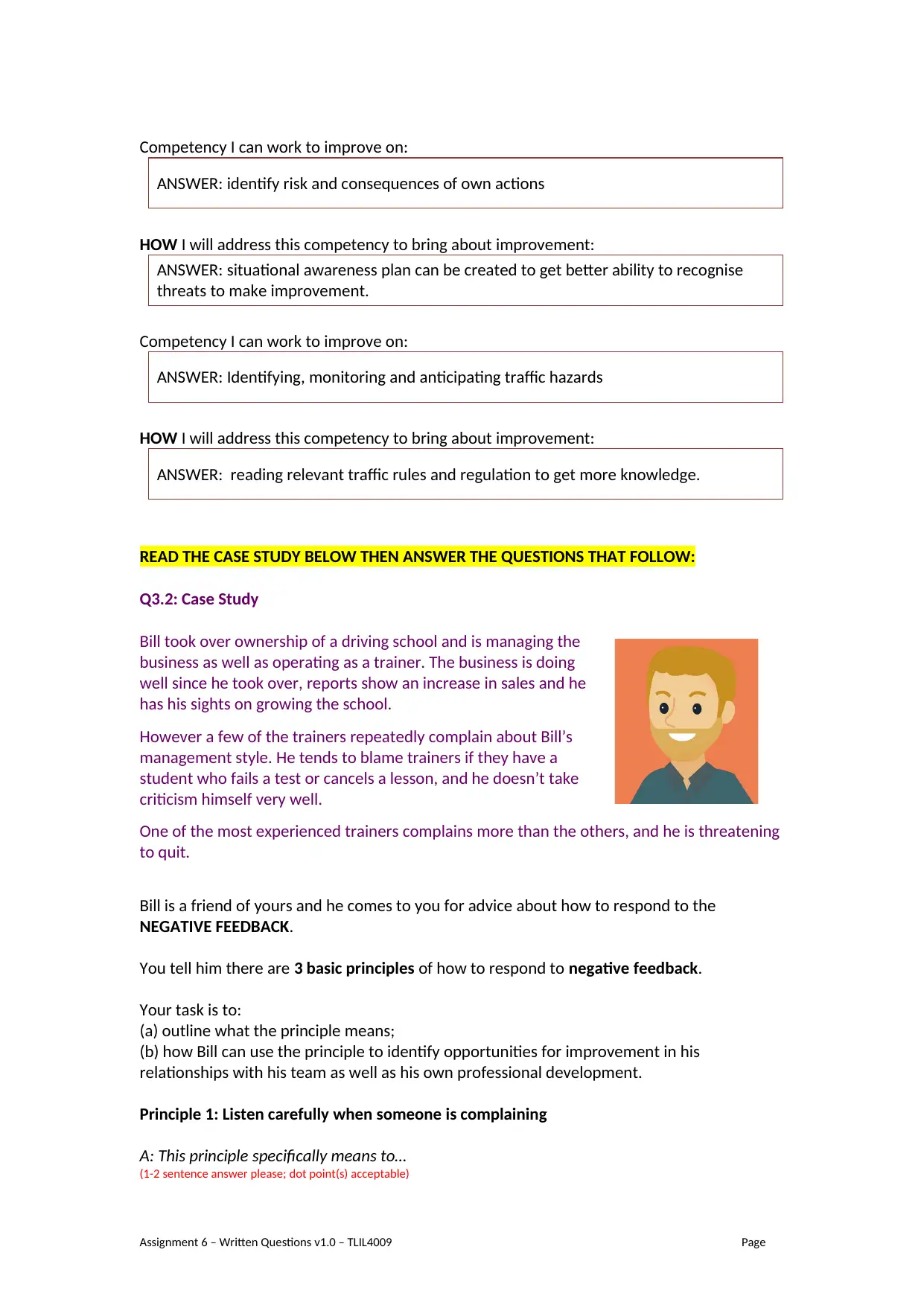
Competency I can work to improve on:
ANSWER: identify risk and consequences of own actions
HOW I will address this competency to bring about improvement:
ANSWER: situational awareness plan can be created to get better ability to recognise
threats to make improvement.
Competency I can work to improve on:
ANSWER: Identifying, monitoring and anticipating traffic hazards
HOW I will address this competency to bring about improvement:
ANSWER: reading relevant traffic rules and regulation to get more knowledge.
READ THE CASE STUDY BELOW THEN ANSWER THE QUESTIONS THAT FOLLOW:
Q3.2: Case Study
Bill took over ownership of a driving school and is managing the
business as well as operating as a trainer. The business is doing
well since he took over, reports show an increase in sales and he
has his sights on growing the school.
However a few of the trainers repeatedly complain about Bill’s
management style. He tends to blame trainers if they have a
student who fails a test or cancels a lesson, and he doesn’t take
criticism himself very well.
One of the most experienced trainers complains more than the others, and he is threatening
to quit.
Bill is a friend of yours and he comes to you for advice about how to respond to the
NEGATIVE FEEDBACK.
You tell him there are 3 basic principles of how to respond to negative feedback.
Your task is to:
(a) outline what the principle means;
(b) how Bill can use the principle to identify opportunities for improvement in his
relationships with his team as well as his own professional development.
Principle 1: Listen carefully when someone is complaining
A: This principle specifically means to…
(1-2 sentence answer please; dot point(s) acceptable)
Assignment 6 – Written Questions v1.0 – TLIL4009 Page
ANSWER: identify risk and consequences of own actions
HOW I will address this competency to bring about improvement:
ANSWER: situational awareness plan can be created to get better ability to recognise
threats to make improvement.
Competency I can work to improve on:
ANSWER: Identifying, monitoring and anticipating traffic hazards
HOW I will address this competency to bring about improvement:
ANSWER: reading relevant traffic rules and regulation to get more knowledge.
READ THE CASE STUDY BELOW THEN ANSWER THE QUESTIONS THAT FOLLOW:
Q3.2: Case Study
Bill took over ownership of a driving school and is managing the
business as well as operating as a trainer. The business is doing
well since he took over, reports show an increase in sales and he
has his sights on growing the school.
However a few of the trainers repeatedly complain about Bill’s
management style. He tends to blame trainers if they have a
student who fails a test or cancels a lesson, and he doesn’t take
criticism himself very well.
One of the most experienced trainers complains more than the others, and he is threatening
to quit.
Bill is a friend of yours and he comes to you for advice about how to respond to the
NEGATIVE FEEDBACK.
You tell him there are 3 basic principles of how to respond to negative feedback.
Your task is to:
(a) outline what the principle means;
(b) how Bill can use the principle to identify opportunities for improvement in his
relationships with his team as well as his own professional development.
Principle 1: Listen carefully when someone is complaining
A: This principle specifically means to…
(1-2 sentence answer please; dot point(s) acceptable)
Assignment 6 – Written Questions v1.0 – TLIL4009 Page
⊘ This is a preview!⊘
Do you want full access?
Subscribe today to unlock all pages.

Trusted by 1+ million students worldwide
1 out of 14
Related Documents
Your All-in-One AI-Powered Toolkit for Academic Success.
+13062052269
info@desklib.com
Available 24*7 on WhatsApp / Email
![[object Object]](/_next/static/media/star-bottom.7253800d.svg)
Unlock your academic potential
Copyright © 2020–2025 A2Z Services. All Rights Reserved. Developed and managed by ZUCOL.





